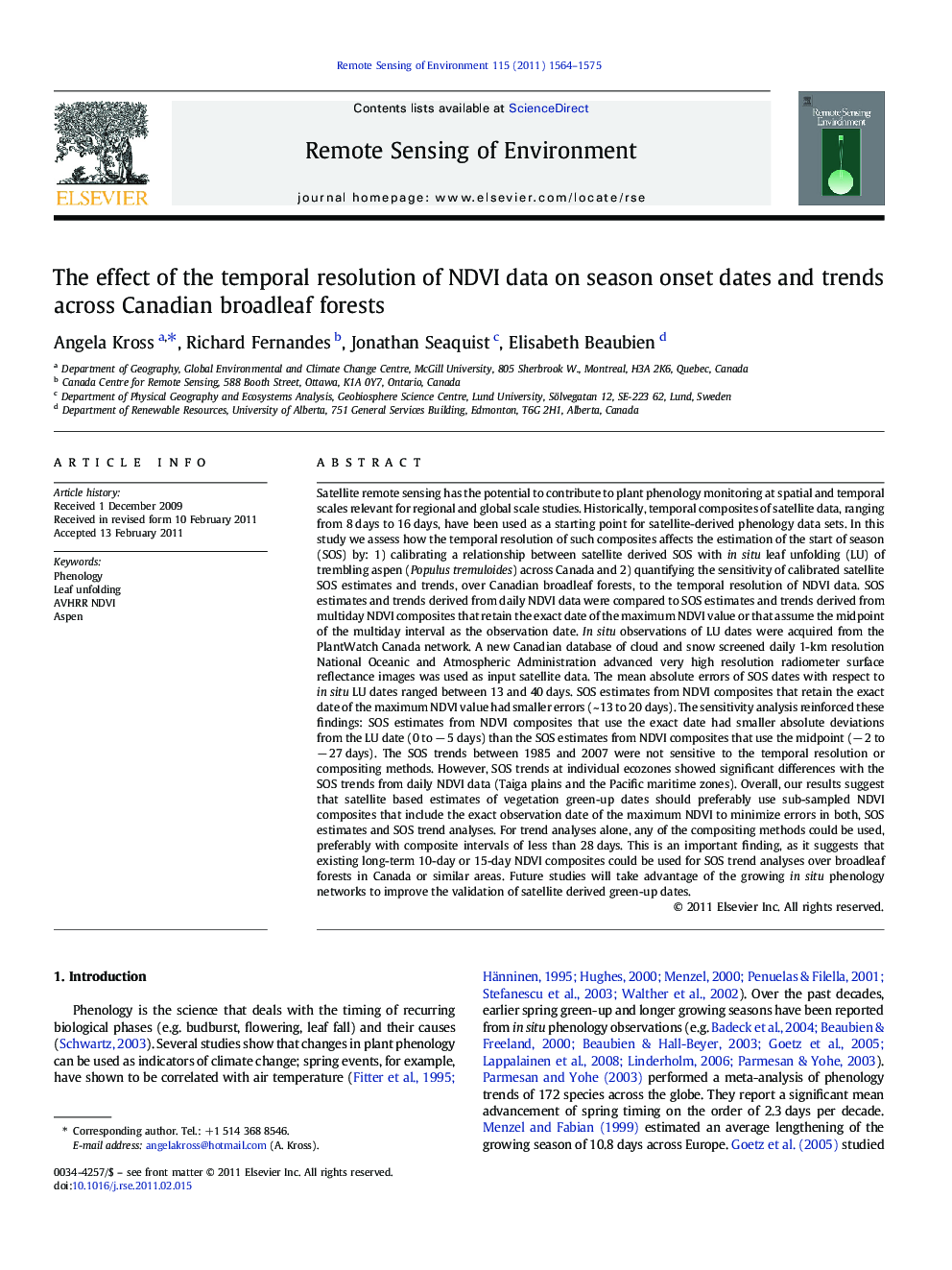| کد مقاله | کد نشریه | سال انتشار | مقاله انگلیسی | نسخه تمام متن |
|---|---|---|---|---|
| 4459393 | 1621291 | 2011 | 12 صفحه PDF | دانلود رایگان |

Satellite remote sensing has the potential to contribute to plant phenology monitoring at spatial and temporal scales relevant for regional and global scale studies. Historically, temporal composites of satellite data, ranging from 8 days to 16 days, have been used as a starting point for satellite-derived phenology data sets. In this study we assess how the temporal resolution of such composites affects the estimation of the start of season (SOS) by: 1) calibrating a relationship between satellite derived SOS with in situ leaf unfolding (LU) of trembling aspen (Populus tremuloides) across Canada and 2) quantifying the sensitivity of calibrated satellite SOS estimates and trends, over Canadian broadleaf forests, to the temporal resolution of NDVI data. SOS estimates and trends derived from daily NDVI data were compared to SOS estimates and trends derived from multiday NDVI composites that retain the exact date of the maximum NDVI value or that assume the midpoint of the multiday interval as the observation date. In situ observations of LU dates were acquired from the PlantWatch Canada network. A new Canadian database of cloud and snow screened daily 1-km resolution National Oceanic and Atmospheric Administration advanced very high resolution radiometer surface reflectance images was used as input satellite data. The mean absolute errors of SOS dates with respect to in situ LU dates ranged between 13 and 40 days. SOS estimates from NDVI composites that retain the exact date of the maximum NDVI value had smaller errors (~ 13 to 20 days). The sensitivity analysis reinforced these findings: SOS estimates from NDVI composites that use the exact date had smaller absolute deviations from the LU date (0 to − 5 days) than the SOS estimates from NDVI composites that use the midpoint (− 2 to − 27 days). The SOS trends between 1985 and 2007 were not sensitive to the temporal resolution or compositing methods. However, SOS trends at individual ecozones showed significant differences with the SOS trends from daily NDVI data (Taiga plains and the Pacific maritime zones). Overall, our results suggest that satellite based estimates of vegetation green-up dates should preferably use sub-sampled NDVI composites that include the exact observation date of the maximum NDVI to minimize errors in both, SOS estimates and SOS trend analyses. For trend analyses alone, any of the compositing methods could be used, preferably with composite intervals of less than 28 days. This is an important finding, as it suggests that existing long-term 10-day or 15-day NDVI composites could be used for SOS trend analyses over broadleaf forests in Canada or similar areas. Future studies will take advantage of the growing in situ phenology networks to improve the validation of satellite derived green-up dates.
Research Highlights
► We examined how the temporal resolution of NDVI affects the start of season (SOS).
► We composed multi-day NDVI composites over 1000 sites between 1985 and 2007.
► SOS was not sensitive when using composites with the exact date of the maximum NDVI.
► SOS trends were not sensitive to the temporal resolution or composing method.
► Existing multi-day NDVI could be used for studying SOS trends of broad leaf forests.
Journal: Remote Sensing of Environment - Volume 115, Issue 6, 15 June 2011, Pages 1564–1575